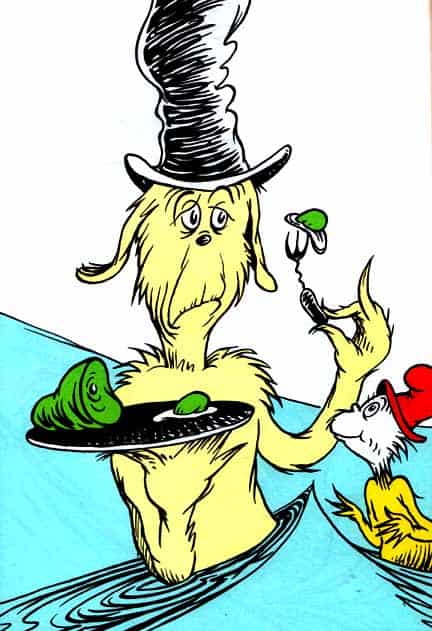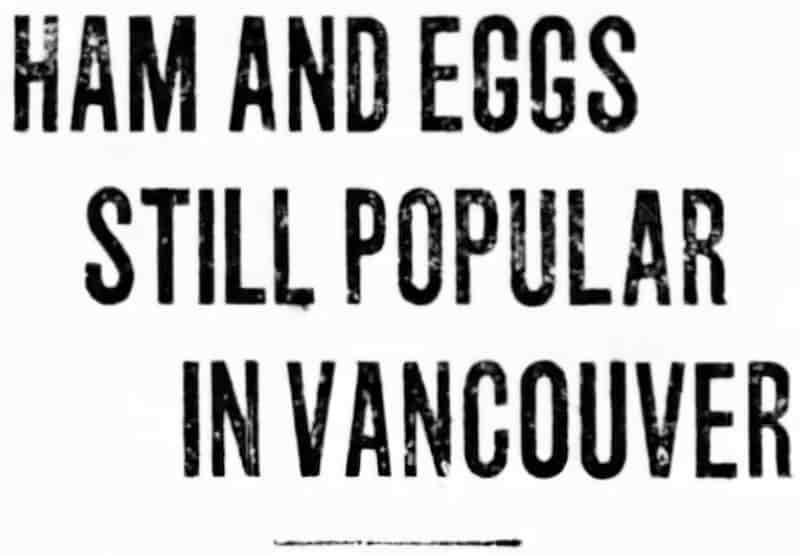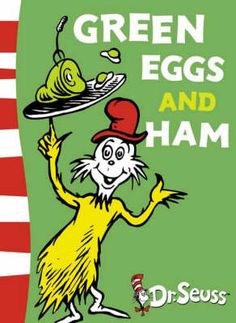This month I’m blogging a series aimed at teaching kids how to structure a story. This seven-step structure works for all forms of narrative. It works for picture books, songs, commercials, films and novels. Today I take a close look at another Dr Seuss early reader, Green Eggs and Ham.
Green Eggs and Ham is buddy comedy from the late 1950s with aspects of the carnivalesque. It also makes use of a mythic journey to beef up the word count and ends in a clear character arc.
Hard to believe, but this book was banned in China, for promoting Marxism. (They lifted the ban after Dr Seuss died.)
STORY STRUCTURE OF GREEN EGGS AND HAM
If Green Eggs and Ham were a movie and not an early reader, it would be called an ‘odd couple’ or ‘buddy comedy’ film.
Planes, Trains and Automobiles is an odd couple film. So is Baby Mama, in which two very different women are thrown together. In both of these films, the very-different characters end up friends. That’s the case with Green Eggs and Ham, too. This is why odd-couple stories are emotionally satisfying.
Sometimes the odd couple never get to be good friends, but by any measure they are best friends anyway. In Diary of a Wimpy Kid, Greg and Rowley are very different and Greg doesn’t even really like Rowley that much, but they spend a lot of time together. The cynical main guy with the optimistic and babyish best friend is also seen in Monster House. Go back to the late eighties, early nineties and we saw this dynamic in The Wonder Years. The late nineties gave us Freaks and Geeks, in which Sam seems very different from his geeky friends. He’s thrown in with them because he’s so small for his age.
These are also called ‘buddy comedies’. The guys are buddies, but the difference between them leads to lots of humour. I say ‘guys’, because there are fewer stories about female friendships in general, unless they’re of the Mean Girls variety. (This is why the film Baby Mama stands out as unusual.) That said, the female buddy story is becoming more popular.
In Green Eggs and Ham we have a cranky, pessimistic guy juxtaposed against an enthusiastic guy. This might as well be Greg Heffley and Rowley, where Rowley is all over something, singing its praises. (But Wimpy Kid is an ongoing series, so Greg Heffley’s character never changes.)
WHO IS THE MAIN CHARACTER?
In a buddy comedy/odd-couple comedy, both characters change. Usually. They take a little bit from each other and become more rounded individuals. In a typical buddy comedy, it’s ‘the relationship’ that changes.
Typical Characters In A Buddy Comedy
A Buddy Love story consists of an “incomplete hero,” who does not know what or who he is missing to make his life whole. The contrast between the two main characters promises entertaining sparks and is therefore appealing.
Usually you fill out the character web with at least one outside, dangerous, ongoing opponent. And because most buddy stories use a mythic journey, the buddies encounter a number of secondary opponents on the road. These characters are usually strangers to the buddies, and they are dispatched in quick succession. Each of these opponents should represent a negative aspect of the society that hates the buddies or wants to break them up.
There will be a snag in the relationship that keeps interfering. This allows an ongoing opposition between the two leads in a traveling story where most of the other opponents are strangers who quickly come and go. In any Buddy Picture Comedy, the buddy is the first opponent.
As in the love story, one of the buddies should be more central than the other. Usually it’s the thinker, the schemer, or the strategist of the two, because this character comes up with the plan and starts them off on the desire line.
Often one’s a cop, the other’s a fed, or one’s a cop the other’s a crook, or one’s a by-the-book detective and the other’s the precinct’s resident loose cannon. They have to work together to get something done (like solve a crime). Buddy cop movies are a slightly different genre mashup: Action+Love+Crime (without the comedy).
In Green Eggs and Ham, Sam-I-Am is a green eggs and ham enthusiast at the beginning and remains the same throughout. There’s no character arc for Sam-I-Am. It is Joey (the cat thing in the hat) who changes. If you’re ever wondering who the main character is in a story, the best question to ask is, ‘Who changes the most?’ That doesn’t mean ‘Who changes in circumstance’. It means ‘Who learns something about themselves’.
Joey is therefore the main character.
What’s wrong with Joey?
Once you’ve created a main character, always ask this question.
He won’t try new foods. This is a recognisable problem for the target audience, who are learning to read.
Stock Yuck
Five-year-olds are usually pretty fussy about green foods. In a clever twist, Dr Seuss avoids the stock yuck of green vegetables (broccoli is the usual stand-in for ‘horrible foods’ in the West), and turns an unlikely thing green. This makes it even more disgusting. In real life you wouldn’t touch green eggs and ham, because it would be rotten and mouldy. When writing our own stories, we can use this trick too: Take a common item and change its attributes.
WHAT DOES JOEY WANT?
Sometimes a story is about what a character does not want.
Joey wants Sam-I-Am to leave him alone. He does not want to eat the green eggs and ham.
When your main character is on the defensive, and the plot is about what they don’t want, the opponent needs to have a strong desire to compensate. (In a story, if no one really wants anything, you don’t have a story.)
OPPONENT/MONSTER/BADDIE/ENEMY/FRENEMY
Sam-I-Am is the opponent, not because he wants to kill Joey or anything like that, but because he wants something different from what Joey wants.
WHAT’S THE PLAN?
Joey’s plan is to run away from Joey so Joey will quit bugging him.
Expressed entirely in the pictures, the pair end up going on a mythic journey which involves hills, the tops of trees, trains, a tunnel and eventually a boat.
BIG STRUGGLE
They end up under the sea. In a mythic structure, the big struggles increase in intensity, leading to a life-or-death situation.
The big struggle of words does not increase in intensity — it remains the same. What happens in this picture book is that the situations get increasingly ridiculous. The ultimate in ridiculous is arguing under water.
WHAT DOES THE CHARACTER LEARN?
We see from Joey’s face when he pops up from the sea that he is defeated.

This marks a change in his attitude. He realises Sam-I-Am won’t leave him alone until he tries the green eggs and ham. So he tries it. And he learns that he loves it.
Notice how this part of the story connects directly to the ‘What’s wrong with Joey’ part of the story? Dr Seuss set up Joey’s great shortcoming right at the beginning and if you’ve read plenty of stories, it’s inevitable that Joey changes his mind about the green eggs and ham.
HOW WILL LIFE BE DIFFERENT FROM NOW ON?
We might assume Joey will be less frightened of new foods in future. But this is a comedy, so it’s just as likely Joey does not apply his newfound love of green eggs and ham to the next unfamiliar thing. He’s just as likely to hate that, too. In comedy, characters never really change. Or if they do change, the change is not applied generally.
The worst part about the book is that at the end, he tries the green eggs and ham and he likes them and starts eating it on boats with goats. And so everyone thinks that’s how it works. You just try something strange and alien and you discover how fabulous it really is, and then you go around holding up signs and riding vaguely dog-like creatures and shouting at people just trying to read the newspaper about how wonderful this thing you tried is. And you shove it in their face to convince them how great it is. But that’s not how it works. That’s not how it ever works.
Asexuality Archive
COMPARE AND CONTRAST GREEN EGGS AND HAM

Green Eggs and Ham was first published in 1957. A much newer (2015) early reader with an almost identical odd couple and character arc is I Really Like Slop, an Elephant and Piggy story from the Mo Willems franchise.
Green Eggs and Ham is longer, at 225 words. I Really Like Slop is only 182 words. This reflects a modern trend in picture books — new stories are shorter than retro classics. (Notably, Green Eggs and Ham contains only 50 different words.)
a, am, and, anywhere, are, be, boat, box, car, could, dark, do, eat, eggs, fox, goat, good, green, ham, here, house, I, if, in, let, like, may, me, mouse, not, on, or, rain, Sam, say, see, so, thank, that, the, them, there, they, train, tree, try, will, with, would, you
Both Green Eggs and Ham and I Really Like Slop are 100 per cent dialogue.
Unlike Mo Willems, Dr Seuss rhymed his stories, using the classic nursery rhyme rhyming scheme, otherwise known as trochaic tetrameter. Dr Seuss was such a cultural influencer that any writer making use of this rhyming scheme ends up compared to Dr Seuss.
Elephant and Piggy stories rely entirely on comedic structure (rather than mythic structure). Comedic structure can only be sustained over a short length of time before spilling the gag at the end. So unless Mo Willems were to take Elephant and Piggie somewhere, placing them in a particular setting (they’re always suspended in space, against a blank background), he wouldn’t be able to sustain more words. Dr Seuss was able to sustain a longer gag by taking his characters on that road trip/mythic journey.


